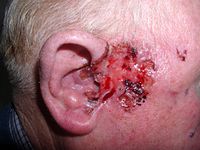
Loss of tRNA methyltransferase 9 and DNA damage response genes in yeast confers sensitivity to aminoglycosides
Sign Up to like & getrecommendations! Published in 2023 at "FEBS Letters"
DOI: 10.1002/1873-3468.14591
Abstract: tRNA methyltransferase 9 (Trm9)‐catalysed tRNA modifications have been shown to translationally enhance the DNA damage response (DDR). Here, we show that Saccharomyces cerevisiae trm9Δ, distinct DNA repair and spindle assembly checkpoint (SAC) mutants are differentially… read more here.
Keywords: dna damage; dna; trna methyltransferase; damage response ... See more keywords

Targeting of lactate dehydrogenase C dysregulates the cell cycle and sensitizes breast cancer cells to DNA damage response targeted therapy.
Sign Up to like & getrecommendations! Published in 2021 at "Molecular oncology"
DOI: 10.1002/1878-0261.13024
Abstract: The cancer testis antigen (CTA) lactate dehydrogenase C (LDHC) is a promising anti-cancer target with tumor-specific expression and immunogenicity. Interrogation of breast cancer patient cohorts from The Cancer Genome Atlas (TCGA) and Molecular Taxonomy of… read more here.
Keywords: dna damage; cell cycle; breast cancer; ldhc ... See more keywords

Hepatocyte Deletion of IGF2 Prevents DNA Damage and Tumor Formation in Hepatocellular Carcinoma
Sign Up to like & getrecommendations! Published in 2022 at "Advanced Science"
DOI: 10.1002/advs.202105120
Abstract: Hepatocellular carcinoma (HCC) is the fifth most common cancer worldwide. Serine‐arginine rich splicing factor 3 (SRSF3) plays a critical role in hepatocyte function and its loss in mice promotes chronic liver damage and leads to… read more here.
Keywords: hepatocellular carcinoma; damage; hepatocyte; dna damage ... See more keywords

LncRNA LIMp27 Regulates the DNA Damage Response through p27 in p53‐Defective Cancer Cells
Sign Up to like & getrecommendations! Published in 2023 at "Advanced Science"
DOI: 10.1002/advs.202204599
Abstract: P53 inactivation occurs in about 50% of human cancers, where p53‐driven p21 activity is devoid and p27 becomes essential for the establishment of the G1/S checkpoint upon DNA damage. Here, this work shows that the… read more here.
Keywords: p27; lncrna limp27; p53 defective; dna damage ... See more keywords

Chromatin Stability as a Target for Cancer Treatment
Sign Up to like & getrecommendations! Published in 2019 at "BioEssays"
DOI: 10.1002/bies.201800141
Abstract: In this essay, I propose that DNA‐binding anti‐cancer drugs work more via chromatin disruption than DNA damage. Success of long‐awaited drugs targeting cancer‐specific drivers is limited by the heterogeneity of tumors. Therefore, chemotherapy acting via… read more here.
Keywords: dna damage; dna; chromatin; treatment ... See more keywords

Cell Fate Regulation upon DNA Damage: p53 Serine 46 Kinases Pave the Cell Death Road
Sign Up to like & getrecommendations! Published in 2019 at "BioEssays"
DOI: 10.1002/bies.201900127
Abstract: Mild and massive DNA damage are differentially integrated into the cellular signaling networks and, in consequence, provoke different cell fate decisions. After mild damage, the tumor suppressor p53 directs the cellular response to cell cycle… read more here.
Keywords: p53; dna damage; cell death; damage ... See more keywords

The DNA Damage Response in Telophase: Challenging Dogmas
Sign Up to like & getrecommendations! Published in 2020 at "BioEssays"
DOI: 10.1002/bies.202000085
Abstract: Cell cycle progression is characterized by the periodic synthesis and destruction of a host of regulatory proteins that produces oscillating waves of activity, such as cyclin-dependent kinase (Cdk) activity, to drive unidirectional advancement through the… read more here.
Keywords: dna damage; cell; damage; cdk activity ... See more keywords

CHRONOCRISIS: When Cell Cycle Asynchrony Generates DNA Damage in Polyploid Cells
Sign Up to like & getrecommendations! Published in 2020 at "BioEssays"
DOI: 10.1002/bies.202000105
Abstract: Polyploid cells contain multiple copies of all chromosomes. Polyploidization can be developmentally programmed to sustain tissue barrier function or to increase metabolic potential and cell size. Programmed polyploidy is normally associated with terminal differentiation and… read more here.
Keywords: polyploid; dna damage; cell cycle; polyploid cells ... See more keywords

The effects of altered DNA damage repair genes on mutational processes and immune cell infiltration in esophageal squamous cell carcinoma
Sign Up to like & getrecommendations! Published in 2023 at "Cancer Medicine"
DOI: 10.1002/cam4.5663
Abstract: Defects in DNA damage repair (DDR) pathways lead to genomic instability and oncogenesis. DDR deficiency is prevalent in esophageal squamous cell carcinoma (ESCC), but the effects of DDR alterations on mutational processes and tumor immune… read more here.
Keywords: cell; cell carcinoma; dna damage; damage repair ... See more keywords

Self‐Cyclizing Antioxidants to Prevent DNA Damage Caused by Hydroxyl Radical
Sign Up to like & getrecommendations! Published in 2017 at "ChemBioChem"
DOI: 10.1002/cbic.201700341
Abstract: Antioxidant therapy is a promising treatment strategy for protecting DNA from the damage caused by reactive oxygen species (ROS). Here, we report new self‐cyclizing antioxidant reagents that are selective for the hydroxyl radical. Our mechanistic… read more here.
Keywords: dna damage; self cyclizing; damage caused; hydroxyl radical ... See more keywords

USP25 inhibits DNA damage by stabilizing BARD1 protein in a house dust mite‐induced asthmatic model in vitro and in vivo
Sign Up to like & getrecommendations! Published in 2022 at "Cell Biology International"
DOI: 10.1002/cbin.11775
Abstract: House dust mites (HDM) can cause DNA double‐strand breaks in the lungs of asthmatic patients. However, the molecular mechanisms driving DNA damage and repair in HDM‐induced asthma are yet to be elucidated. Thus, in this… read more here.
Keywords: vivo; hdm; damage; dna damage ... See more keywords